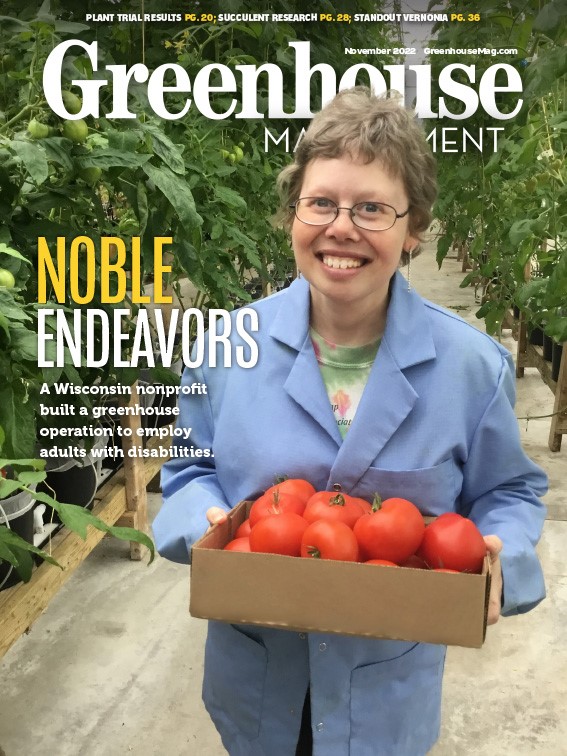

Growing up, Les Frost was fascinated by his uncle’s retail greenhouse. He could hardly wait until he was old enough to start working there, so as soon as he turned 13, he “prevailed upon” his mom to help him get a job in the greenhouse.
“I didn’t know anything else I wanted to do more,” says Frost, who has dedicated his entire career to growing.
He went on to earn a horticulture degree from Pennsylvania State University, and then returned to work in his uncle’s business for another 10 years until the business was sold. At that point, in 1988, Frost moved to Stan’s Garden Center in Erie, Pennsylvania, where he’s been working as head grower ever since.
Frost joined Stan’s soon after the operation began moving from its original location to a new site a couple miles down the road. Today, this site encompasses 4.5 acres under cover, where Frost and his team of about a dozen people produce bedding plants, hanging baskets and annuals for retail customers.
Proper watering
Although many moving parts are involved in Stan’s growing operation, Frost says water management is the first priority.
“That might sound menial, but water management plays into nutrition, disease management and growth rates, and it also goes a long way toward determining the ultimate plant quality,” Frost says.
Even though Stan’s upgraded to an automatic watering system with sprinklers and spaghetti tubes, there’s still a manual aspect to watering.
“When you’re holding a hose and not just programming sprinklers, it gets you out there,” Frost says. “You’re able to look at the plant and see if something’s wrong, if it’s growing at the right rate, and if you see signs of insects or disease.”
That’s why, when training new employees, Frost puts a lot of emphasis on proper watering. This involves plant-specific education to teach his team which crops like to dry out between waterings and which ones don’t.
“I make a big deal about getting the watering done early in the day,” he says. “I’m a stickler for not having wet foliage late in the day. I’ve seen the incidence of diseases like botrytis plummet just from doing that one cultural control to keep the foliage dry at the end of the day.”



Targeted pest management
One of the biggest changes to Frost’s growing approach has been pest management.
“Back then, we were doing what we call a ‘spray and pray’ approach, where you spray everything every week and hope it works,” he says, “which was horribly time-consuming and unpleasant.”
Since then, Frost has transitioned to an integrated pest management (IPM) system where he monitors plants with sticky cards and informal scouting. Crops are only treated when necessary. Certain pest-prone crops still get preventative treatments, “particularly things like hanging baskets,” he says, because “you don’t want to pull them down on Mother’s Day weekend and see that they’re loaded with aphids.”
Several years ago, Frost started incorporating biocontrols and beneficial insects into his pest management program.
“We decided to start with the poinsettia crop because you’ve only got one crop in the greenhouse and basically one pest, whitefly, that affects it,” he says.
After a couple years of success, Frost tried to cut costs in the program by removing Amblyseius swirskii predatory mites, because they’re supposed to target thrips more than whiteflies. But when he cut out them out, the pests came back, and he realized the mites were also eating immature whiteflies. Reintroducing them to the program provided better control.
“We’ve had some startling successes with biocontrols and some disappointments as well,” Frost says. “We’re still trying to learn what kills what, under what circumstances, and whether we can integrate certain pesticides with biocontrols. We’ve hardly mastered it, but it’s taken a big chunk out of our traditional spraying. I’m spending less time and using less product now on four times as much space than I was 30 years ago on an area a fraction of the size.”


Growth cycle
Over more than 40 years in this industry, Frost has seen significant changes in the greenhouse — like the introduction of plugs and automated systems for watering, pot filling, climate control and transplanting.
Still, he finds that technology can’t entirely replace the human touch required to grow top-quality plants. For example, after experimenting with automated transplanters, Frost noticed that plants didn’t acclimate as well as they did after manual transplanting, so they decided to keep doing it by hand. Likewise, even with automated watering systems, Frost stresses the importance of manual watering to keep an eye on the plants.
After all, what drew Frost to the greenhouse in the first place was the allure of working with plants and watching them grow.
“You get to see something grow from start to finish,” he says. “People in other industries might only make one part of the product they’re producing, but they don’t get to see the finished product. We do, and that’s satisfying.”

Explore the November 2022 Issue
Check out more from this issue and find your next story to read.
Latest from Greenhouse Management
- Chilli thrips (Scirtothrips dorsalis)
- GS1 US Celebrates 50-Year Barcode 'Scanniversary' and Heralds Next-Generation Barcode to Support Modern Commerce
- University of Florida offers Greenhouse Training Online program on irrigation water
- Flower trends in full bloom
- ‘Part of our story’
- Dramm introduces new hose, sprinkler attachments for home gardeners, nurseries
- Nominate an outstanding leader
- Profile Products hires sales and business development manager for Europe and Asia





